Meringue cookies are light, crispy, delicate cookies made with just three ingredients! They make for great gifts and are perfect treats to snack on during the holidays.
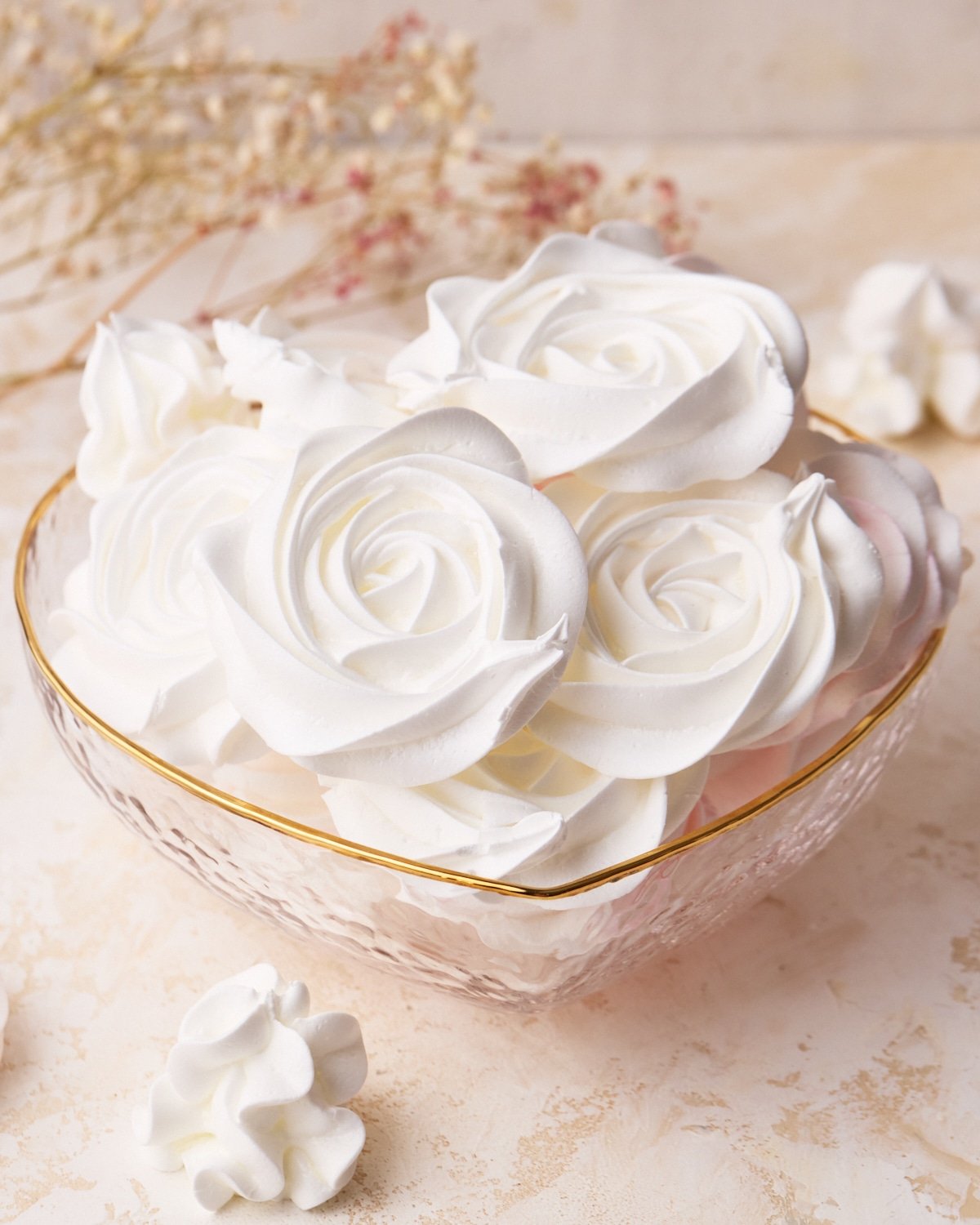
As an experienced baker who has spent years working with meringues in every form - from indulgent toppings to towering pavlovas - I've learned exactly how to balance sugar, egg whites, and technique to achieve cookies that are feather-light and hold their shape, with no weeping, cracks, or unwanted chewiness.
In this recipe, I'll walk you through not just the how but also the why behind each step, breaking down the science of meringue so you'll understand what's happening at every stage - from whipping the perfect peaks to drying them so they have that irresistible, melt-in-your-mouth crunch. These detailed, tested methods are what will transform your meringues from a frustrating gamble into consistently bakery-quality cookies you can rely on every time.
Jump to:
Why You'll Love These Meringue Cookies
- Easy cookie recipe with just two main ingredients.
- Fully customizable with flavors, colors, and shapes to suit any occasion or gift.
- Expert-tested recipe with detailed instructions and baking science insights.
What are Meringue Cookies?
Meringue cookies are French meringue that has been piped and baked at a low temperature to create light, crispy cookies that are sweet and will crumble and melt in the mouth. These adorable cookies can be sandwiched with tasty fillings, flavored with various mix-ins, and piped into any shape you like - making them perfect for a holiday cookie tray or a DIY gift.
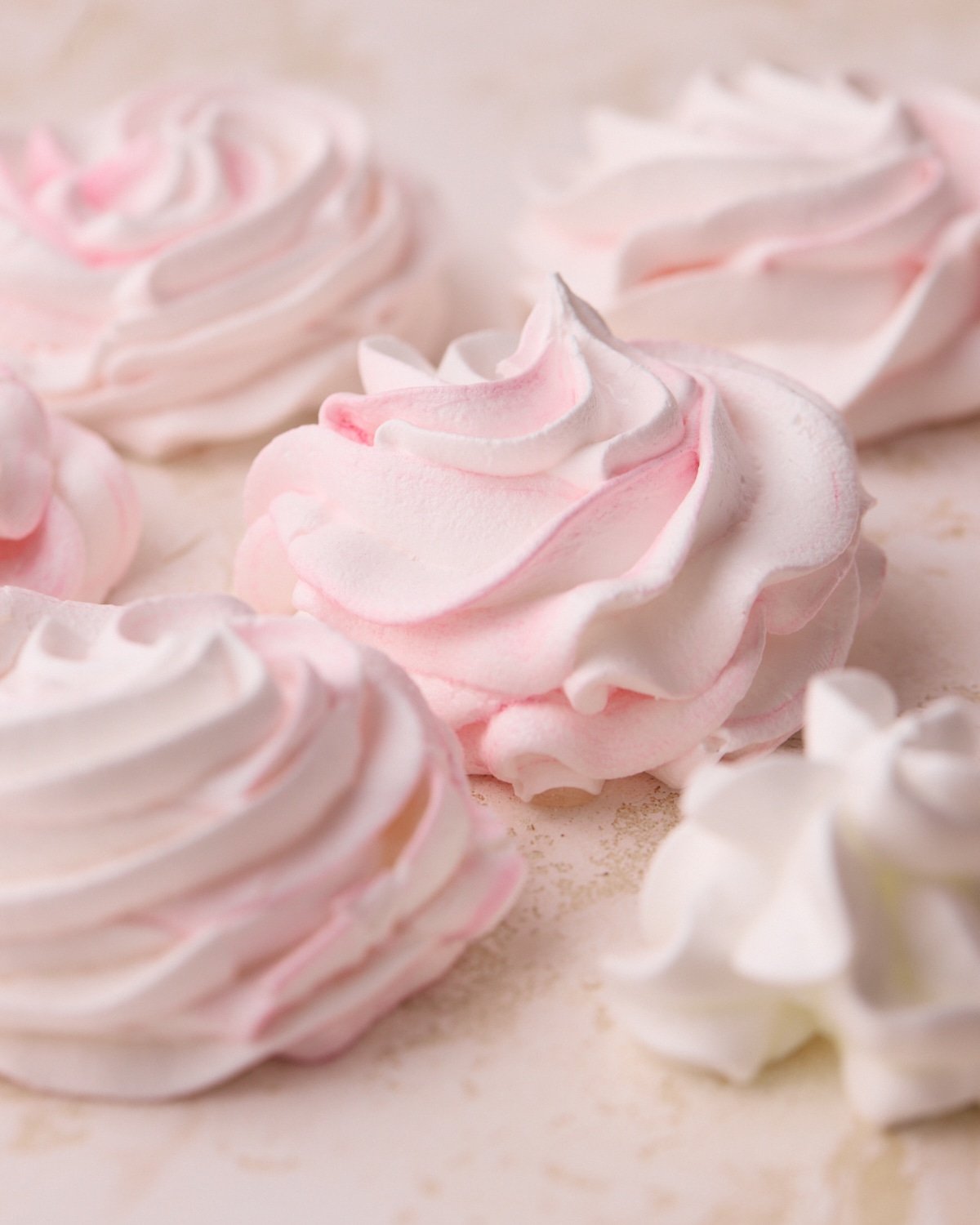
Meringue Recipe Ingredients
You need just 3 ingredients to make this easy meringue cookie recipe. It's essential to follow the ingredient guidance below, as it will make all the difference to your cookies!
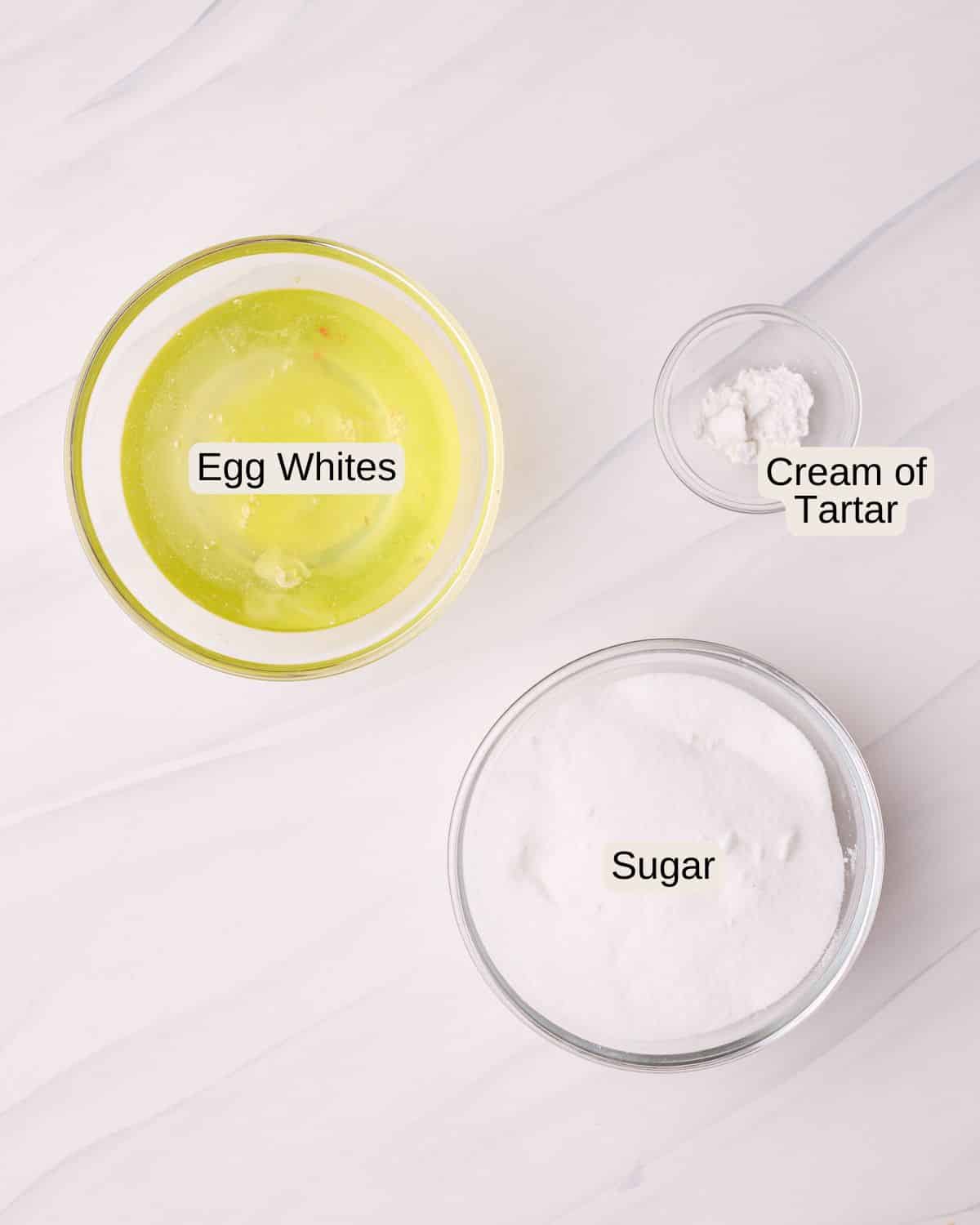
- Egg Whites - For meringue, you only need the large egg whites. Though it may be tempting to use carton egg whites, it's better to use fresh eggs and separate them, as boxed egg whites won't whip up as well. You don't have to waste the egg yolks, though - save them to use in another recipe, like pastry cream or custard pie!
- Sugar - Superfine sugar is best for French meringue as it dissolves easily into the egg whites without being heated.
- Cream of Tartar - The acid in cream of tartar helps stabilize the eggs, allowing the cookies to hold their shape better and achieve a light, airy texture with a glossy finish. You can substitute it for 1 teaspoon of lemon juice or white vinegar.
Tip: It's easier to separate the eggs while they are cold, then let the egg whites come to room temperature before whipping.
See the recipe card for quantities and the full meringue cookie recipe.
Recommended Equipment
- Stand Mixer - with a whisk attachment. You can also use an electric mixer and a large bowl.
- Cookie Sheet
- Piping Bag - with star tip (optional).
How To Make Meringue Cookies
These simple meringue cookies are so easy to make. The steps are very straightforward, but there are a few key details to pay close attention to to make sure they turn out perfectly.

Whip Eggs
Preheat the oven to 225°F / 105°C (90° fan-assisted) and line a large cookie sheet with parchment paper.
Add the room temperature egg whites and cream of tartar to the bowl of a stand mixer and whip on low speed for 1-2 minutes, until the egg whites are foamy and opaque. Do not go straight in with high speed, or you'll make large air bubbles and an unstable meringue.

Incorporate Sugar
Gradually turn up the mixer to medium-high speed, then begin adding the sugar one tablespoon at a time. Allow the mixture to whip for 15-30 seconds between each addition so the sugar fully dissolves. Once all the sugar has been incorporated, continue whipping for another 30 seconds.
To check if it's ready, rub a little meringue between your fingers - it should feel completely smooth. If it's still gritty, keep whipping.

Whip to Stiff Peaks
Scrape down the sides of the mixing bowl, then whip on high speed until the meringue is glossy and forms stiff peaks, with tips that stand upright without drooping.
Optional: You can add some vanilla and a pinch of salt here for extra flavor.
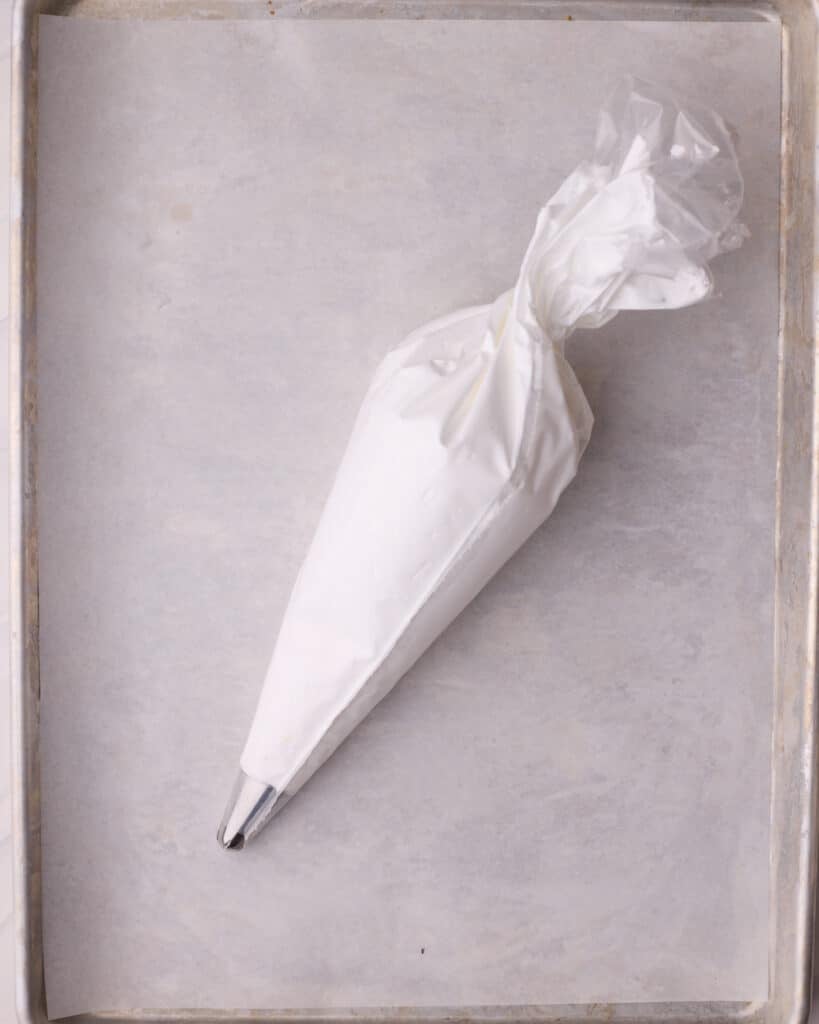
Prepare Cookie Sheet
Transfer the meringue to a piping bag fitted with a star piping tip. Dab a small amount of meringue under each corner of the parchment paper to help secure it in place.

Pipe Cookies
Pipe the meringue mixture into cookies in any shape or size you like - swirls, roses, or little nests all work beautifully. You could also pipe little meringue kisses for bite-sized cookies.
For a simpler look, you can skip the piping bag and spoon dollops of meringue onto the baking sheet instead.
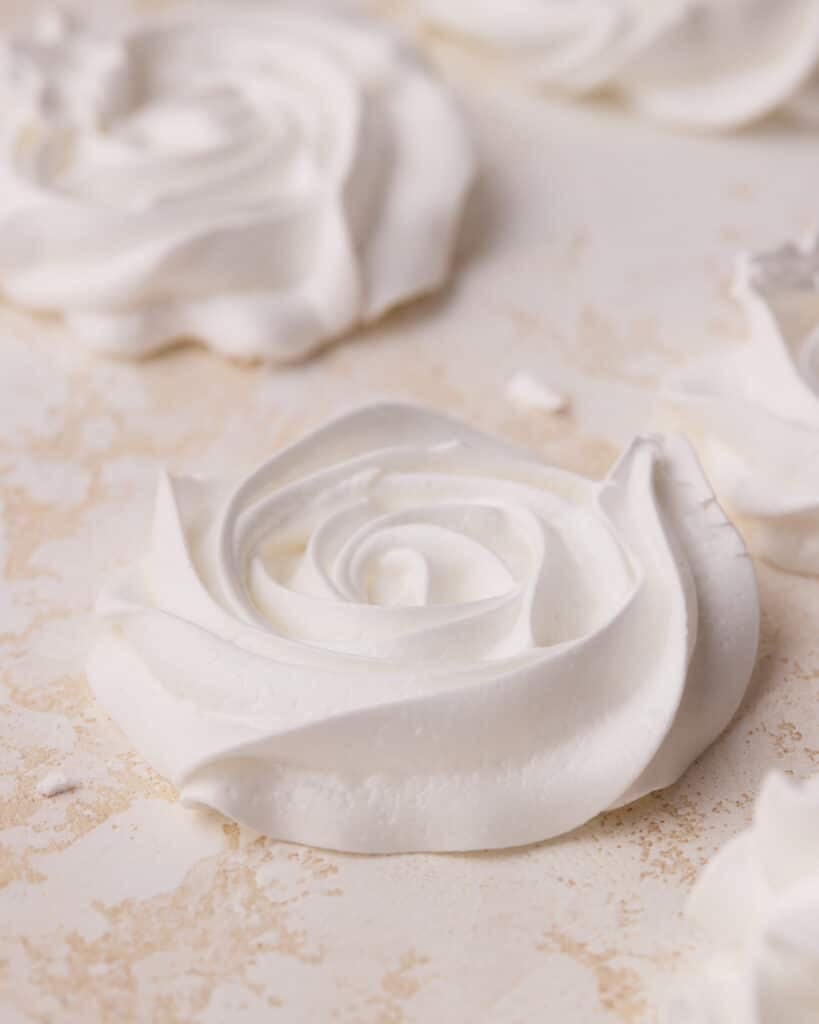
Bake
Bake for 1½ to 2 hours, or until the meringue cookies are completely dry. Turn off the oven and let them cool inside until they reach room temperature, keeping the oven door closed.
This gentle cooling process helps them dry fully and prevents cracking.
How to Know When Meringue Cookies are Baked
Bake times will depend on the size and shape of your cookies. To see if they're done, touch the outside - it should be completely dry. Gently lift one from the tray - if it comes away from the parchment paper easily, they're ready! If it sticks, let them bake a little longer. Keep the tray in the oven while checking so you don't shock the meringues with a sudden temperature change.

Expert Tips for Perfect Meringue Cookies
Though the process of making meringue is so simple, there is a lot of science going on under the surface - here are my top pastry chef tips to make sure you make the very best meringues every time.
- Separating Eggs - Egg whites whip up best at room temperature, but it's easier and cleaner to separate cold eggs. Separate the eggs straight from the fridge, then let the whites sit out until they reach room temperature before whipping.
- Fat - Even the tiniest bit of fat can stop egg whites from whipping properly, so make sure your stand mixer bowl is spotless - wiping it down with a paper towel and a little lemon juice or vinegar works wonders. Be extra careful when separating the eggs, too; even a trace of yolk can ruin your meringue. I always separate each egg into a small bowl first - this way, if a yolk breaks, it won't spoil the whole batch.
- Whip Slowly - Many meringue recipes will tell you to just whip the egg whites on high speed until thick and glossy, but for the very best results, you want to increase the speed gradually. This will form smaller air bubbles to create a more stable structure, rather than larger bubbles, which are more likely to deflate later.
- Sugar - Adding the sugar gradually gives each spoonful a chance to fully dissolve before the next goes in. If any sugar remains undissolved, the meringues can weep during or after baking, so it's important to check for any grittiness as you go.
- Low and Slow - Baking meringues at a low oven temperature for a long time lets them dry out gently, keeping them perfectly white and preventing cracks. Patience is essential for that delicate, melt-in-your-mouth texture.
- Baking - Don't underbake your meringues. If they aren't completely dried out, they can start to weep or sweat, leaving you with soggy cookies. Take your time and let them dry fully in the oven, even if it feels like they're done on the outside. This may take up to a couple of hours.
- Weather - It might sound strange, but the weather can play a huge part in the texture of meringue if you live in a typically humid country. Humidity can cause the meringue cookies to turn out soft and sticky rather than crispy and dry, so it's best to avoid making them on a particularly humid day - a dry day is the best for meringues.
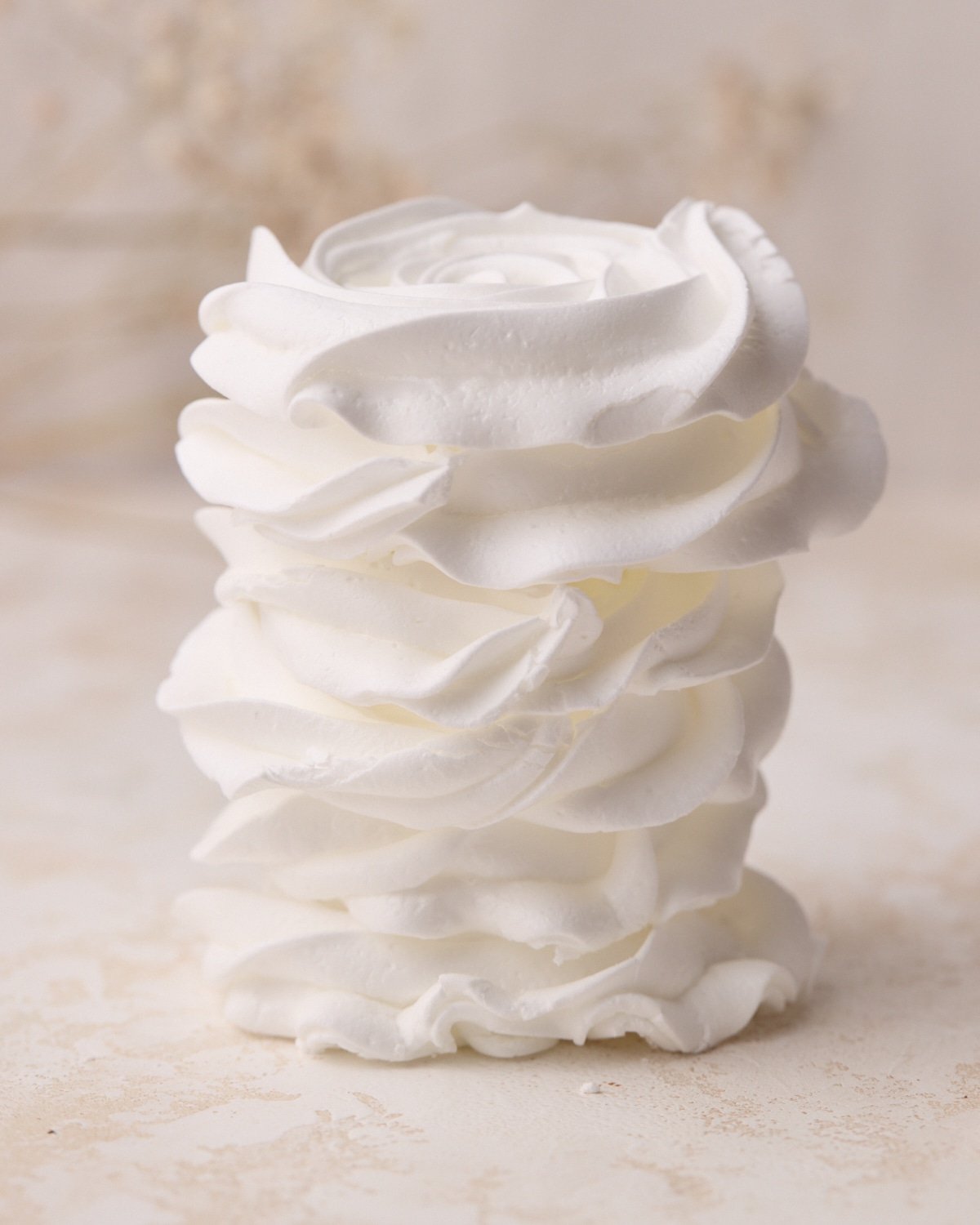
Serving Suggestions
These meringue cookies are wonderfully versatile - the way you serve them can transform them entirely.
You can simply enjoy them on their own for a light treat that you can leave in the cookie jar or gift in little gift bags.
For something a little more indulgent, sandwich two meringue cookies together with a dollop of fresh whipped cream, strawberry jam, or lemon curd - try pumpkin curd in fall! They make a great make-ahead dessert, especially with a drizzle of homemade caramel sauce or strawberry coulis, or dipped in melted chocolate.
My personal favorite way to enjoy meringue cookies is to crush them up and sprinkle them over strawberries and cream - a little like Eton Mess! Any fresh fruit will go wonderfully with them.

Flavoring, Coloring, and Variations
Meringue cookies are a blank canvas, and it's easy to customize them with different flavors, textures, and styles. Here are a few fun ideas to try:
- Flavoring the meringue - When it comes to adding flavor to meringue, concentrated or dry ingredients are the best thing - think extracts and powders. Add them once the meringue has reached stiff peaks, and whip just long enough to combine. Some of my favorites are almond or vanilla extract, freeze-dried strawberry powder, espresso powder, or a pinch of warm spices (perfect for the holidays). Cocoa powder makes lovely chocolate meringue cookies, while citrus zest brightens them up for orange, lime, or lemon meringue cookies.
- Mix-ins - The list is endless when it comes to mix-ins! They add flavor, texture, and color to your pretty meringue cookies. Stir ingredients like chopped nuts, shredded coconut, freeze-dried fruit pieces, or chocolate chips into the meringue mixture. Gently fold the mixins into the meringue at the very end, once the meringue is at the stiff peak stage - be careful not to knock out too much air. Alternatively, you can add wetter ingredients like jam, pistachio cream, or Nutella - swirl it into the piping bag or on top of the meringue mounds.
- Colors - To get a pretty swirl of color in your meringue cookies, paint a strip of gel food coloring up the inside of the piping bag before adding the meringue to it. It looks really beautiful! If you would like the entire meringue to be all one color, gently fold a few drops of food coloring into the meringue mixture once it has reached stiff peaks. You can experiment with a few different colors by separating the mixture into different bowls before adding the coloring.
- Different Shapes - Whether you're using a piping bag or a spoon to form your meringue cookies, you can create some cute shapes to make them extra special. With a spoon, you can form simple shapes like hearts or rustic mounds. A pastry bag and piping tip do, however, give you much more freedom to make some exciting shapes. With a large star tip, you can create stars, roses, swirls, and meringue kisses. I love to make little Christmas trees for my holiday cookie plates by using green food coloring and a French tip.
- Meringue Pops - This is the best way to serve individual meringue cookies! Simply lay down a few popsicle sticks on your prepared baking sheets and pipe your desired meringue shape on the end of each stick. Then, pipe the same shape onto the sheet (without the stick) to sandwich together later with melted chocolate. They make for great gifts that are super easy to make.
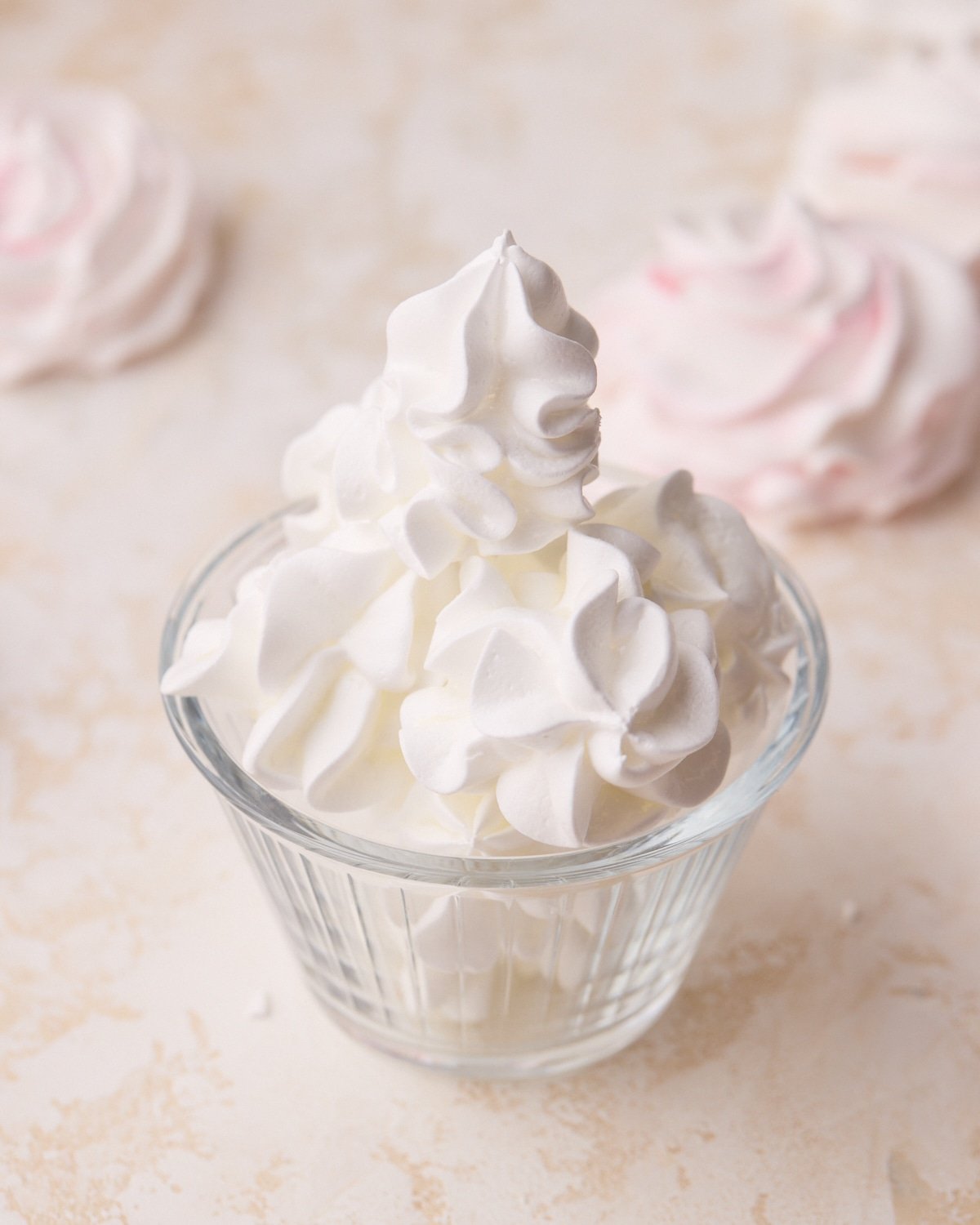
How To Store Meringue Cookies
Store your meringue cookies in an airtight container at room temperature. If stored in a dry place, they will stay good for up to 2 weeks. If sandwiching your cookies with a filling, be sure to store them separately and fill them on the day of serving.
Do not store meringue cookies in the refrigerator, as the moisture will make them go weepy and soggy.
Meringue Cookies FAQ
If you have a question about this recipe that isn't answered here, please write it in the comment section, and I will get back to you as soon as I can.
Meringue cookies and mini pavlovas look quite similar, but have a different texture. Meringue cookies are baked until they are completely dry all the way through, making them crispy and airy. Mini pavlovas are baked at a slightly higher temperature for less time, meaning they keep that marshmallowy texture of chewy meringues while having a crisp outer shell.
Meringue cookies are baked at a very low temperature to dry out slowly without browning or cracking. This gentle heat gives them their crisp, melt-in-your-mouth texture. If you were to bake at a higher temperature, they wouldn't dry out on the inside, and the outside would turn golden brown, rather than staying bright white.
Yes, meringue cookies do need to be whipped up to stiff peaks. This gives them the structure to hold their shape while baking and ensures they turn out light, crisp, and airy. If you were to whip them to soft peaks, the meringue wouldn't have enough structure to hold its shape, and the cookies would spread, lose definition, and lose their crispy texture.
Meringue cookies are made with French meringue, which means that sugar is whipped into raw egg whites. This is different from other types of meringues, such as Swiss meringue, which cooks the egg whites over a double boiler to bring them to a safe temperature for consumption. It's not necessary to heat the egg whites for these cookies because the meringue is baked in the oven, which cooks the eggs.
Cream of tartar helps with the structure and stability of the meringue, but you can make it without. You can also substitute another acid, such as lemon juice or white vinegar.
More Easy Cookie Recipes
Here are some more tasty cookie recipes that are super simple to make!
Recipe

Meringue Cookies Recipe
Ingredients
- 4 Large Egg Whites (room temperature)
- 1 cup Superfine Sugar 200g
- ½ teaspoon Cream of Tartar
Equipment
- Stand Mixer with whisk attachment
- Piping Bag optional
- Star Piping Tip optional
Instructions
- Preheat the oven to 225°F / 105°C (90° fan-assisted) and line a large cookie sheet with parchment paper.
- Add the egg whites and cream of tartar to the bowl of a stand mixer and whip on low speed for 1-2 minutes until they become foamy and opaque. Starting on low speed helps to develop smaller air bubbles for a more stable meringue.4 Large Egg Whites, ½ teaspoon (½ tsp) Cream of Tartar
- Gradually increase the speed to medium-high, then start adding the sugar, one tablespoon at a time, letting it mix in for 15-30 seconds in between each spoonful to allow the sugar to fully dissolve.1 cup (200 g) Superfine Sugar
- Once all the sugar has been added, whip for another 30 seconds, then test the meringue to make sure the sugar has dissolved by rubbing some of it between your fingers - it should feel completely smooth. If it feels gritty at all, keep whipping.
- Scrape down the sides of the bowl and then turn the mixer up to high speed and whip until stiff, glossy peaks form. This means that the peaks stand up straight with no drooping.
- Transfer the meringue to a piping bag with a star piping tip and dot a small blob of meringue on the underside of each of the four corners of the parchment paper, to help it stick to the baking sheet.
- Pipe your meringue out in any shape you like. I like to do swirls or roses. Alternatively, you can skip the piping bag and use a spoon to just scoop mounds of meringue onto your baking sheet for a more rustic look.
- Bake for 1½ to 2 hours, until the meringue cookies are completely dry. When they are fully baked, they should feel dry to the touch and lift away from the parchment paper easily (check this without taking them out of the oven).
- Turn the oven off and leave the meringue cookies inside with the oven door shut to allow them to cool gradually. This will dry them out slowly and avoid shocking them or cracking.

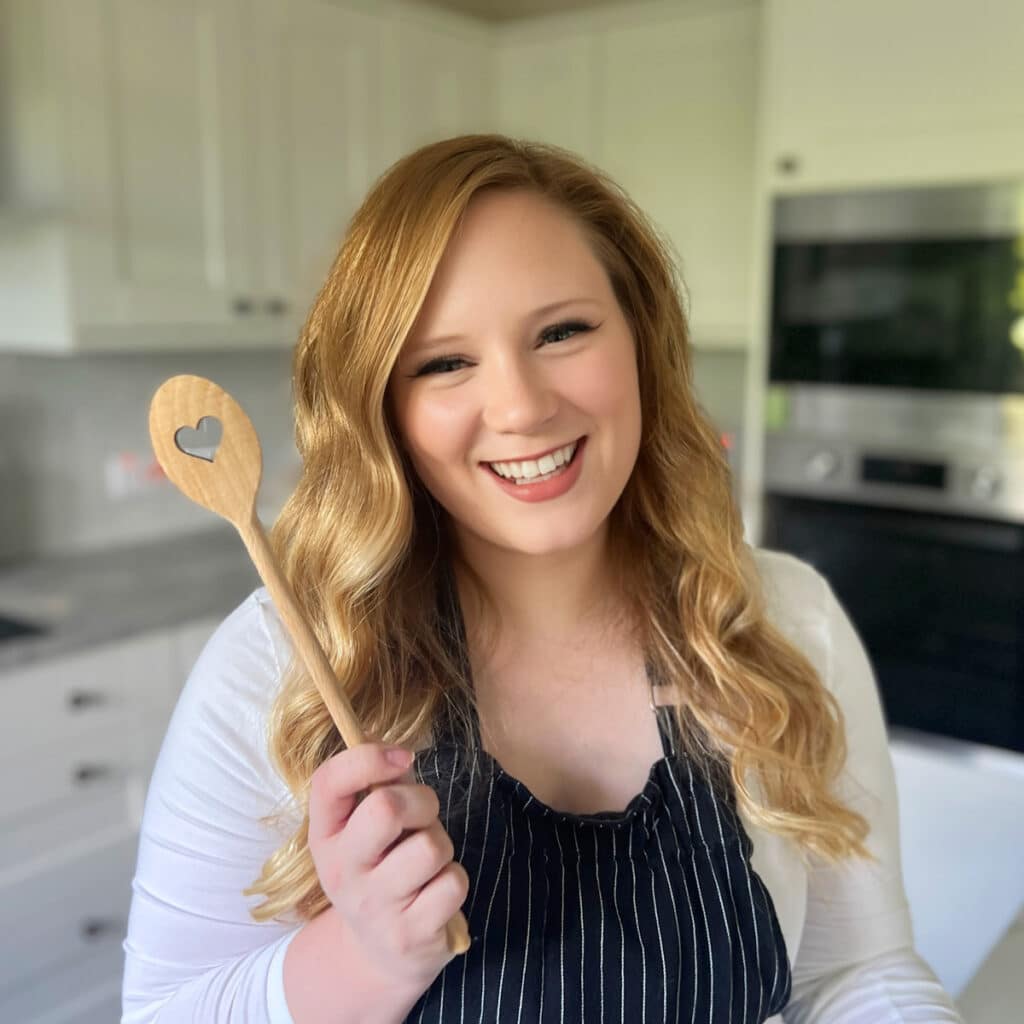
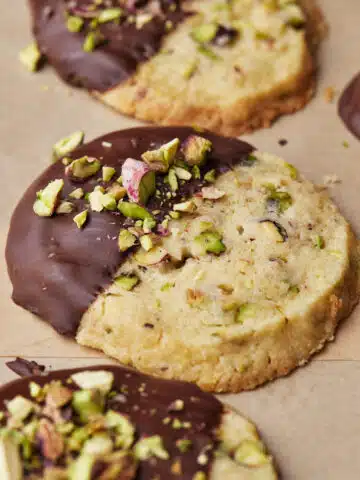
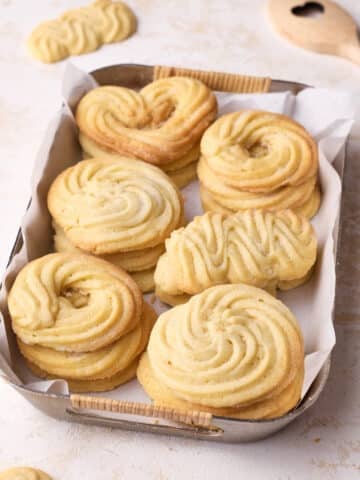

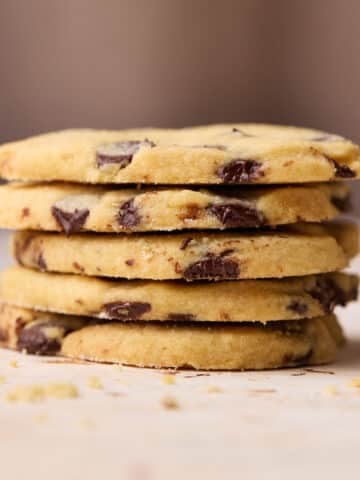

Lewis
Excellent recipe - perfect every time